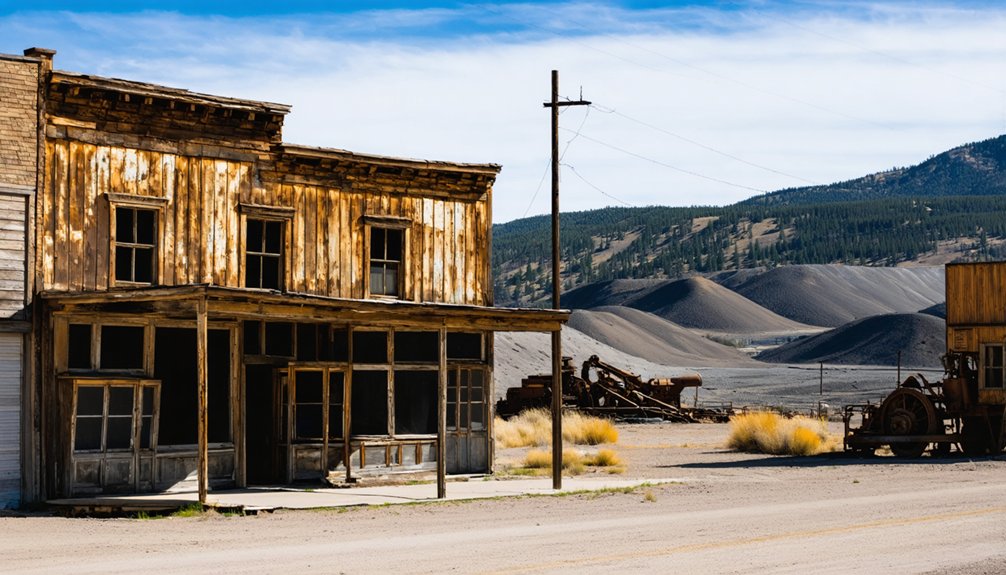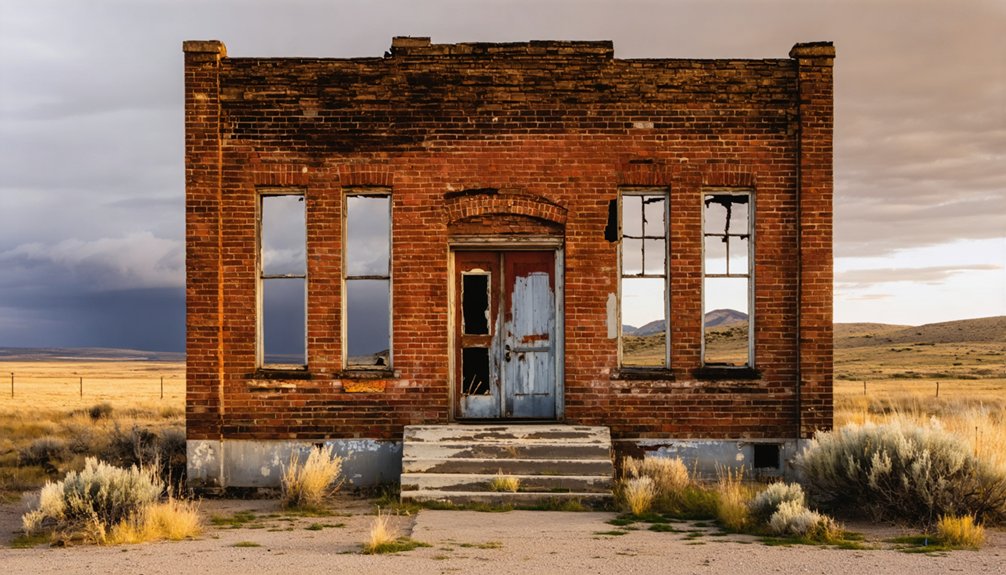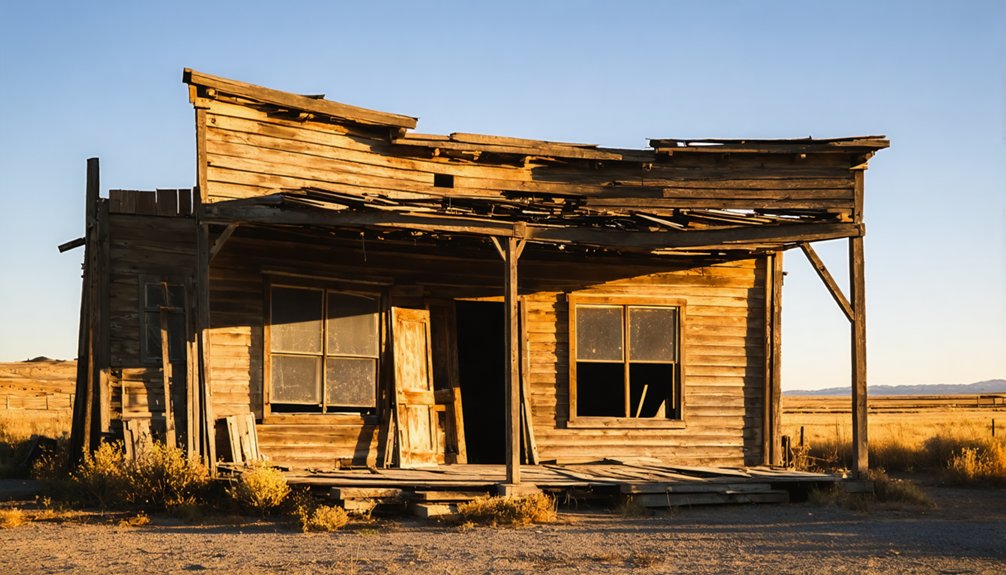You’ll find this silver boomtown from 1879 tucked away in Idaho’s Salmon River Mountains, where it once bustled with 400 residents during its peak. The town flourished through the 1880s and 1890s, generating $10 million in silver production before declining due to falling prices and natural disasters. Today, you can explore the well-preserved ghost town‘s stone buildings, mining structures, and 0.9-mile loop trail – each weathered facade holds stories of frontier life waiting to be discovered.
Key Takeaways
- Bayhorse is a preserved ghost town in Idaho that once thrived as a silver mining community with up to 400 residents.
- Founded in 1879, the town generated $10 million in silver production before declining due to falling metal prices and natural challenges.
- Visitors can explore historic structures along a 0.9-mile loop trail, including buildings constructed by Italian immigrants.
- The site is part of Land of the Yankee Fork State Park, featuring mining equipment, stone buildings, and interpretive signs.
- The town’s decline was triggered by a smelter closure, destructive fire, and water shortages, leading to its abandonment by 1925.
The Birth of a Silver Boomtown
When prospectors discovered rich silver deposits near Bayhorse Creek in 1879, they couldn’t have known their find would establish one of Idaho’s most significant mining districts. The settlement’s curious name stems from an early incident where a horse tumbled into the creek during exploration.
You’ll find that Bayhorse’s geological formations yielded an impressive mix of minerals. While silver was the primary draw, the veins also contained valuable deposits of lead, zinc, and traces of gold. The district reached its peak production in 1888 before beginning a gradual decline. The town grew substantially and reached a population of nearly 300 residents during its most prosperous years.
As word of the silver discovery spread, miners flocked to the area, transforming the remote mountain location into a bustling boomtown. Their mining techniques evolved quickly, and by 1885, the district was employing 200 men across several major mines, including the Post Boy, Utah Boy, and Ramshorn operations.
Life in Bayhorse’s Golden Age
During its peak in the late 1880s, Bayhorse thrived as a bustling community of 400 residents, where miners’ families and single workers created a vibrant mountain society.
You’d find cultural influences throughout the town, especially in the enduring stone buildings constructed by skilled Italian immigrants. Daily life centered around essential establishments like saloons, general stores, and boarding houses, where you could grab a hot meal or swap stories after a long shift. The town’s main source of income came from the Bayhorse Mine operations that produced valuable silver and lead deposits. The Wells Fargo building stood prominently in brick at the center of town, serving as a vital connection to the outside world.
Life wasn’t easy, though. You’d need true grit to weather the harsh winters and face the daily risks of mining work.
Despite the challenges, the community pulled together, with nearly 200 men working the mines while their families built a home in this rugged landscape, proving that frontier spirit could overcome nature’s harshest tests.
Mining Operations and Economic Impact
The discovery of rich mineral deposits in the 1860s and early 1870s set Bayhorse on a path to becoming one of Idaho’s most productive mining districts.
Rich mineral finds transformed Bayhorse from wilderness into a mining powerhouse, shaping Idaho’s industrial landscape for generations to come.
Mining technology advancements, including innovative ore reduction processes and the construction of nine stone charcoal kilns, transformed the area into a thriving industrial center.
You’ll find evidence of the district’s impressive $10 million production legacy, which included silver, gold, lead, and copper.
The mining operation’s scale is reflected in these key developments:
- An aerial tramway built in 1883 revolutionized ore transportation
- A state-of-the-art refinery established in 1885 enabled on-site silver bar production
- Workforce dynamics supported 300-400 residents at peak operations
The site’s peak production years occurred from 1882 through the 1890s, marking its most prosperous era.
Despite challenges like fires and water shortages, Bayhorse’s mining operations continued until 1925, leaving an indelible mark on central Idaho’s development.
Recent environmental initiatives have successfully addressed soil contamination issues through comprehensive rehabilitation projects.
Daily Life and Community Infrastructure
During Bayhorse’s heyday, you’d find the town’s social and business activities centered around its essential gathering spots, including bustling saloons, general stores, and boarding houses.
These establishments served as more than just places of commerce – they provided vital meeting points where miners could unwind after grueling shifts and where families could connect with their neighbors. The harsh winter conditions meant these gathering places became even more crucial as snow and cold kept residents close to town.
The Wells Fargo bank, jail, and doctor’s office rounded out the town’s infrastructure, offering residents the basic services needed to maintain a functioning mining community in Idaho’s remote frontier. The buildings were primarily constructed using locally sourced wood, reflecting the practical needs of the mining settlement.
Mining Town Social Hubs
As miners trudged home from exhausting shifts in Bayhorse’s silver mines, five bustling saloons served as the town’s primary social hubs, where workers could unwind over card games and share news of the day.
The saloon culture extended beyond just drinking – these establishments doubled as essential community gathering spots where you’d find job leads, local gossip, and camaraderie among the town’s 300 residents.
- You could grab a hot meal at nearby restaurants and meat markets, which formed a lively commercial district around the saloons.
- You’d find miners mixing with engineers and cooks in the adjacent boardinghouses, where work talk flowed freely.
- You might catch informal music sessions or join storytelling circles during precious moments of leisure between shifts.
The town’s inclusion in Land of the Yankee Fork State Park in 2006 helped preserve these historic social spaces for future generations to explore.
By 1900, the town had produced an impressive ten million dollars in ore, reflecting the prosperity that supported these vibrant social establishments.
Essential Community Services
Beyond the bustling saloons, life in Bayhorse required a complex web of basic services to sustain its mining population. You’d find wooden boarding houses and modest cabins clustered near mine sites, where residents shared communal water sources from mountain streams and relied on basic outhouses for sanitation.
Daily survival meant adapting to limited resources. You couldn’t count on formal healthcare practices – injuries and illnesses were often treated through community knowledge and visiting physicians.
Educational provisions were similarly makeshift, with children likely taught in shared spaces or homes. Local general stores supplied essential goods, though you’d need to supplement with hunting or gardening.
When winter storms isolated the town, you’d depend on your neighbors’ support and resourcefulness to overcome challenges in this rugged mountain settlement.
The Decline of a Mining Empire

While Bayhorse had flourished as a thriving mining town throughout the 1880s, its fate took a dramatic turn by decade’s end.
Economic fluctuations hit hard when silver and lead prices plummeted, making mining operations unsustainable despite advances in mining technology like the aerial tramway. The closure of the local smelter in 1889 dealt a crushing blow, forcing miners to ship ore to distant facilities at great expense.
The town’s decline accelerated due to three devastating factors:
- A destructive fire in 1889 that ravaged key structures
- Severe water shortages that crippled ore processing
- Harsh winter conditions at 6,000+ feet that isolated the community
Modern-Day Ghost Town Experience
Today’s visitors to Bayhorse Ghost Town can explore this remarkably preserved slice of Idaho’s mining history through a well-maintained 0.9-mile loop trail that winds past weathered buildings and historic mining structures.
Step into Idaho’s mining past along Bayhorse Ghost Town’s scenic trail, where preserved buildings tell stories of frontier life.
You’ll find informative signs detailing the town’s struggles with fire and water shortages, while preservation efforts by state and federal agencies guarantee these stories won’t be lost to time.
As part of the Land of the Yankee Fork State Park’s ghost town tourism circuit, Bayhorse offers year-round access, though you’ll want to check conditions during winter months.
While large RVs aren’t permitted, you can easily park and walk the grounds, combining historical preservation with outdoor recreation.
The surrounding mountain landscape provides opportunities for wildlife viewing and photography, creating an authentic frontier experience.
Frequently Asked Questions
Are There Any Reported Ghost Sightings or Paranormal Activities in Bayhorse?
You’ll find ghost stories about a crazed miner’s spirit, with spectral encounters reported near the old mill and mines, including metallic shrieks, shadowy figures, and unexplained presences felt by tour guides.
What Happened to the Original Residents After Leaving Bayhorse?
Like scattered seeds in the wind, you’ll find the residents dispersed amid economic decline – some returned to their homelands, others moved to nearby mining towns, while many embraced new careers across America.
Can Visitors Collect Mineral Specimens or Artifacts From the Site?
You can collect mineral specimens using hand tools for personal use, but you can’t remove artifacts – they’re legally protected for preservation and represent important historical heritage.
Is Camping Allowed Within the Historic Ghost Town Boundaries?
Imagine yearning to sleep where miners once dwelled – but you can’t. Camping regulations strictly forbid overnight stays within the ghost town boundaries. You’ll need to use designated campsites outside the historic area.
What Are the Best Months to Visit Bayhorse for Photography?
You’ll find the best photography months between May and October, with summer delivering long daylight hours and autumn offering dramatic colors. Golden-hour lighting during these months creates stunning seasonal lighting opportunities.
References
- https://rvertv.tv/blogs/news/bayhorse-ghost-town-a-journey-into-idaho-s-historical-past
- https://en.wikipedia.org/wiki/Bayhorse
- https://abandonedidaho.com/2024/12/17/bayhorse-historical-photos/
- https://www.thetravel.com/what-to-know-about-bayhorse-idaho-ghost-town/
- https://history.idaho.gov/wp-content/uploads/2018/09/Bayhorse_76000671.pdf
- https://www.youtube.com/watch?v=FTa6GRbOTUo
- https://www.aol.com/articles/why-bayhorse-ghost-town-one-014810483.html
- https://www.idahogeology.org/pub/Staff_Reports/1999/S-99-8.pdf
- https://www.legendsofamerica.com/id-bayhorse/
- https://westernmininghistory.com/towns/idaho/bayhorse/



